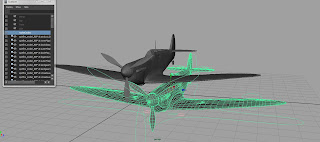The following shows the progress of my Pilot rig in its initial stages.
This particular rig was a very challenging piece of work. Rather than setting up the IK spline that may usually go into creating the back joints, I followed a tutorial that builds all the components of the IK spline from scratch. We start with a a set of disjoined joints placed along the spine. A CV curve is then placed on each joint. From here the details are rather complicated, but to summarize the back was eventually made from two sets of spine joints, with an additional neck joint at the top and a root bone at the base of the spine. Eventually the goal of this set up is to create an advance twist function that can more accurately create human postures.
With all the fundamental objects in place, it was now time to fix the appropriate expressions and connections that will eventually govern them. Here are the results from the set up. At this point rotations in one orientation are affecting the locators when the actual twist hasn't been set up. In the next post you may see the fully working spine















